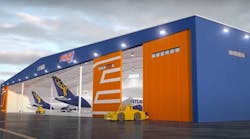KUALA LUMPUR, Malaysia, Oct. 24, 2012 /PRNewswire/ -- China's commercial aviation sector, the world's second-largest in terms of air traffic and passenger turnover, has presented its maintenance, repair, and overhaul (MRO) market with new opportunities. Increased domestic aircraft utilization and larger fleets positively influence the local market. Better infrastructure and support services over a wide product system have allowed the migration of maintenance activities to China, further adding impetus to the fastest-growing MRO market in the world.
New analysis from Frost & Sullivan (http://www.aerospace.frost.com), China Commercial Aircraft and Engine MRO Market Opportunities, finds that the market earned revenues of over US$2.66 billion in 2011 and estimates this to reach US$6.39 billion in 2020.
China's gross national product (GNP) saw a 9.7 percent rise in the first quarter of 2011, and its economic growth is expected to go up by an average of 7.0 percent over the next few years. Air traffic growth in the country will account for nearly 8.4 percent of the global total, compelling carriers to optimize the use of aircrafts to meet travel demands.
"Currently, 28 percent of the MRO work is sourced to companies outside China," said Frost & Sullivan Industry Analyst Reshma Bhandary. "However, the trend is expected to reverse as the country's MRO service providers expand their capabilities and capacities."
Aircrafts in service will be the major source of revenue, as Chinese airlines prefer to contract their maintenance work to domestic suppliers. New heavy maintenance bases in China's secondary cities are also growing popular, saving end users the associated costs of positioning flights.
However, competition within the domestic arena is stiff. The top four airlines own MRO facilities or operate through joint ventures. Winning new business from these airline-associated MROs appears unlikely.
Moreover, original equipment manufacturers (OEMs) seeking vertical integration have intensified competition. A well-established, third-party component repair network has further made breaking into the line and component maintenance segments particularly difficult.
For market entrants to be successful, they need to strategically position themselves early in the new airframe and engine MRO service space.
"Focusing on the commercial aircraft engine front, which is the second-largest sub-market by revenue, could be rewarding in the long term," noted Bhandary. "The engine MRO market's lower reliance on labor rates will also reduce costs and supplement revenue."
Catering to next-generation aircrafts and the worldwide customer demand will drive the MRO landscape in China.
If you are interested in more information on this research, please send an email to Donna Jeremiah, Corporate Communications, at [email protected], with your full name, company name, title, telephone number, company email address, company Web site, city, state and country.
China Commercial Aircraft and Engine MRO Market Opportunities is part of the Aerospace Growth Partnership Services program, which also includes research in the following markets: North American Military Aircraft and Engine MRO Market, Growth Monitor - Aerospace and Defense, New Routes to Profitability - Reinventing the Airline Business Model. All research services included in subscriptions provide detailed market opportunities and industry trends that have been evaluated following extensive interviews with market participants.
About Frost & Sullivan
Frost & Sullivan, the Growth Partnership Company, works in collaboration with clients to leverage visionary innovation that addresses the global challenges and related growth opportunities that will make or break today's market participants.
Our "Growth Partnership" supports clients by addressing these opportunities and incorporating two key elements driving visionary innovation: The Integrated Value Proposition and The Partnership Infrastructure.
The Integrated Value Proposition provides support to our clients throughout all phases of their journey to visionary innovation including: research, analysis, strategy, vision, innovation and implementation. The Partnership Infrastructure is entirely unique as it constructs the foundation upon which visionary innovation becomes possible. This includes our 360 degree research, comprehensive industry coverage, career best practices as well as our global footprint of more than 40 offices.
For more than 50 years, we have been developing growth strategies for the global 1000, emerging businesses, the public sector and the investment community. Is your organization prepared for the next profound wave of industry convergence, disruptive technologies, increasing competitive intensity, Mega Trends, breakthrough best practices, changing customer dynamics and emerging economies?
SOURCE Frost & Sullivan


